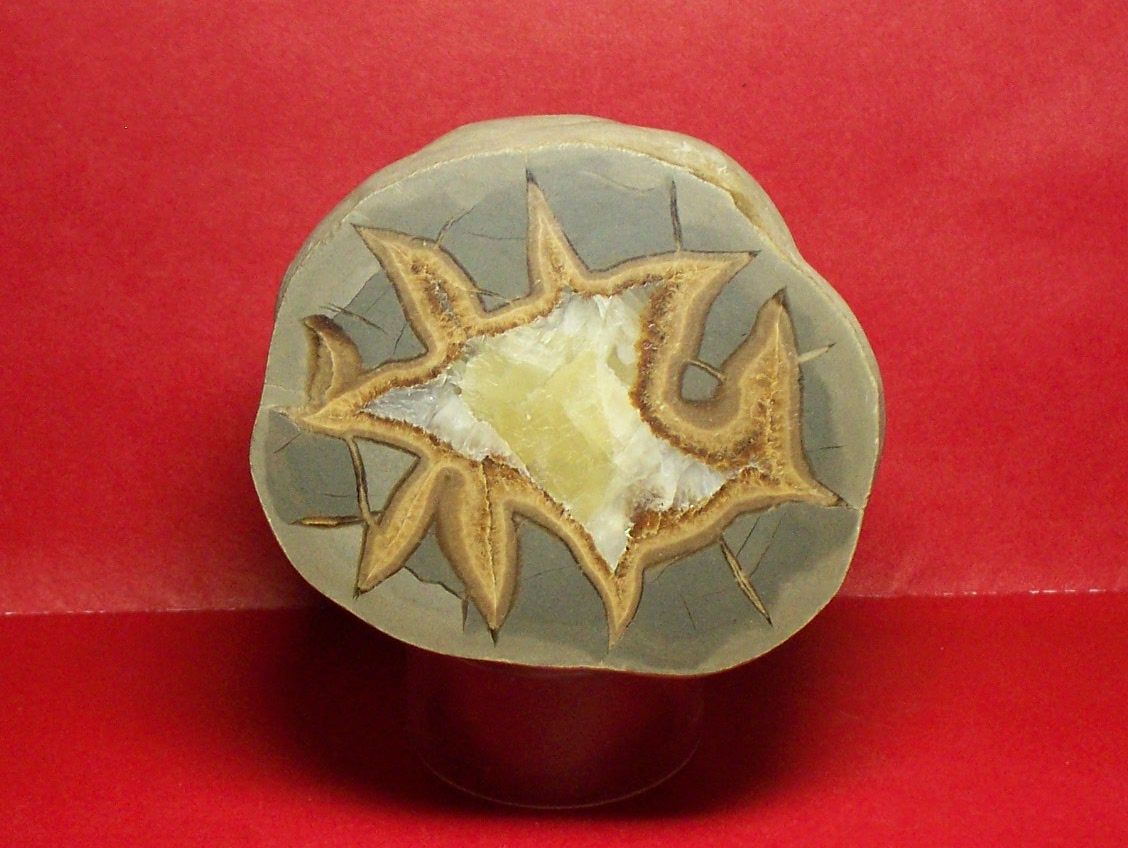odarby
off to a rocking start

Member since August 2013
Posts: 5 
|
Post by odarby on Aug 18, 2013 0:02:04 GMT -5
|
|
|
|
Post by vegasjames on Aug 18, 2013 0:04:26 GMT -5
No idea, but sure looks cool. First glance reminds me of a turtle shell.
|
|
|
|
Post by deb193redux on Aug 18, 2013 0:07:17 GMT -5
I wonder if it could be fossil shell
|
|
odarby
off to a rocking start

Member since August 2013
Posts: 5 
|
Post by odarby on Aug 18, 2013 0:26:52 GMT -5
Gotta be a petrified dino egg,..?,..
|
|
|
|
Post by kk on Aug 18, 2013 0:37:25 GMT -5
Should be an interesting discussion, we had someone from Indonesia asking that question on a similar piece a few months back.
|
|
odarby
off to a rocking start

Member since August 2013
Posts: 5 
|
Post by odarby on Aug 18, 2013 0:46:59 GMT -5
This was overturned when bulldozing a wetland area,.."Flooding Control",..was with a nest of about 6 similar State of Oregon.
Any links to the "Indonesian" discussion??
|
|
|
|
Post by helens on Aug 18, 2013 0:54:51 GMT -5
Wow... what the heck? How big is it?
You sure the in between parts aren't concrete/masonry (doesn't look like it, but had to ask).
|
|
odarby
off to a rocking start

Member since August 2013
Posts: 5 
|
Post by odarby on Aug 18, 2013 0:59:22 GMT -5
Wow... what the heck? How big is it? You sure the in between parts aren't concrete/masonry (doesn't look like it, but had to ask). I am in the masonry business (sort of) this is definitely not concrete. It measures 9" X 9" |
|
|
|
Post by helens on Aug 18, 2013 1:10:05 GMT -5
That is one of the most baffling things I've ever seen. I just googled 'fossilized egg', then 'fossilized turtle shell', and it doesn't look anything like either one. Here's a pix of a whole bunch of fossilized turtle shells together... not even close:  But there's too much structural cohesion to be just a brecciated rock?? Maybe you should email the photos to your nearest University Geology dept or even state geologist? I'd think they'd be real curious too!! |
|
|
|
Post by texaswoodie on Aug 18, 2013 6:18:09 GMT -5
Septarian
|
|
|
|
Post by jakesrocks on Aug 18, 2013 9:38:21 GMT -5
Exactly what I was thinking Mel. Septarian nodule. Looks like the exterior has seen quite a bit of weathering. Cut through the middle and polished, it should show neat calcite and possibly barite patterns. |
|
|
|
Post by Peruano on Aug 18, 2013 9:40:30 GMT -5
I vote with woodie- Septarian. Yours looke like it is mudstone or ?, but sometimes they are quite hard, and capable of being polished. I have found a few on beaches in Mexico. Tom
|
|
|
|
Post by jakesrocks on Aug 18, 2013 10:52:12 GMT -5
odarby, cut and polished you may come up with something like this.  The gray areas are only a very hard clay rock, and will only take a dull polish. But any calcite and/or barite will take a very nice polish. This is my smallest septerian. Only about 4" across. I have one that is about a foot across, and have seen them much larger. Here's a link to pics of Septerian nodules. Several look almost exactly like yours. (No 2 look alike). www.google.com/search?q=Septerian+nodules&hl=en&tbm=isch&tbo=u&source=univ&sa=X&ei=U-8QUqidNKnW2wXBooGoAg&ved=0CEEQsAQ&biw=1280&bih=499Oh, and welcome to the forum. Be sure to post lots of pics of your finds. We love pics, and can all learn from them. |
|
jamesp
Cave Dweller 
Member since October 2012
Posts: 36,602
Member is Online
|
Post by jamesp on Aug 18, 2013 11:56:33 GMT -5
Septerian, but do not know what it is
|
|
|
|
Post by jakesrocks on Aug 18, 2013 12:11:28 GMT -5
Hey Jim. here's a brief description of what septarian nodules are. Note they say aragonite. Many found in South Dakota have barite instead. www.bestcrystals.com/septarian.htm |
|
|
|
Post by helens on Aug 18, 2013 12:12:53 GMT -5
|
|
Steve
has rocks in the head
  
Member since June 2005
Posts: 506
|
Post by Steve on Aug 18, 2013 12:15:28 GMT -5
I think it is a fossilized mud ball - otherwise known as a septarian nodule (as others have already said). Often you can find fossil clams and ammonites in the matrix.
|
|
|
|
Post by jakesrocks on Aug 18, 2013 12:33:45 GMT -5
I think it is a fossilized mud ball - otherwise known as a septarian nodule (as others have already said). Often you can find fossil clams and ammonites in the matrix. Steve, it's a Bentonite clay, which when it dries becomes very hard, and nearly water proof. As it dries and shrinks, cracks form. The cracks infill with calcite and aragonite or barite. |
|
jamesp
Cave Dweller 
Member since October 2012
Posts: 36,602
Member is Online
|
Post by jamesp on Aug 18, 2013 12:43:14 GMT -5
Thanks Don. The images are utterly amazing. As are the formation.
|
|
Deleted
Deleted Member
Member since January 1970
Posts: 0
|
Post by Deleted on Aug 18, 2013 12:52:59 GMT -5
yeah, seems to be a VERY nice specimen of septarian nodule. If you grind it just right you can make them into a sphere that looks like this:  Yours might be too flat for that. But it seems like such a nice one, you might wanna leave it as is. |
|